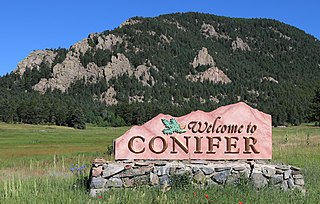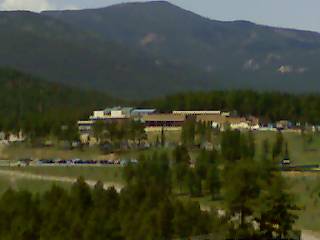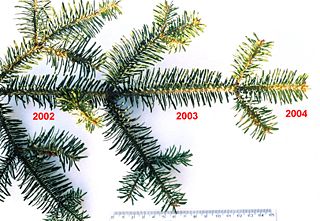
In botany, an evergreen is a plant that has leaves throughout the year that are always green. This is true even if the plant retains its foliage only in warm climates, and contrasts with deciduous plants, which completely lose their foliage during the winter or dry season. There are many different kinds of evergreen plants, both trees and shrubs. Evergreens include:

The order Pinales in the division Pinophyta, class Pinopsida, comprises all the extant conifers. This order used to be known as the Coniferales.
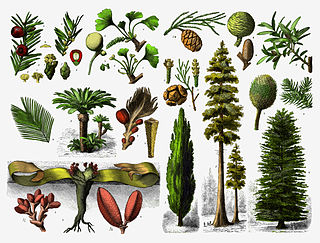
The gymnosperms, also known as Acrogymnospermae, are a group of seed-producing plants that includes conifers, cycads, Ginkgo, and gnetophytes. The term "gymnosperm" comes from the Greek composite word γυμνόσπερμος, meaning "naked seeds". The name is based on the unenclosed condition of their seeds. The non-encased condition of their seeds stands in contrast to the seeds and ovules of flowering plants (angiosperms), which are enclosed within an ovary. Gymnosperm seeds develop either on the surface of scales or leaves, which are often modified to form cones, or solitary as in Yew, Torreya, Ginkgo.
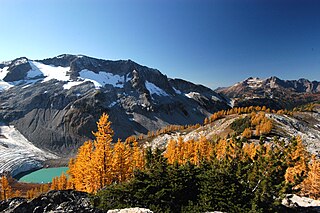
The Pinaceae are trees or shrubs, including many of the well-known conifers of commercial importance such as cedars, firs, hemlocks, larches, pines and spruces. The family is included in the order Pinales, formerly known as Coniferales. Pinaceae are supported as monophyletic by their protein-type sieve cell plastids, pattern of proembryogeny, and lack of bioflavonoids. They are the largest extant conifer family in species diversity, with between 220 and 250 species in 11 genera, and the second-largest in geographical range, found in most of the Northern Hemisphere, with the majority of the species in temperate climates, but ranging from subarctic to tropical. The family often forms the dominant component of boreal, coastal, and montane forests. One species, Pinus merkusii, grows just south of the equator in Southeast Asia. Major centres of diversity are found in the mountains of southwest China, Mexico, central Japan, and California.

Podocarpaceae is a large family of mainly Southern Hemisphere conifers, comprising about 156 species of evergreen trees and shrubs. It contains 19 genera if Phyllocladus is included and if Manoao and Sundacarpus are recognized.

A cone is an organ on plants in the division Pinophyta (conifers) that contains the reproductive structures. The familiar woody cone is the female cone, which produces seeds. The male cones, which produce pollen, are usually herbaceous and much less conspicuous even at full maturity. The name "cone" derives from the fact that the shape in some species resembles a geometric cone. The individual plates of a cone are known as scales.

The USCGC Conifer was a 180 foot seagoing buoy tender. Conifer and her sister ships, commonly referred to as "one-eighties", served as the backbone of the Coast Guard's Aids to Navigation fleet for over 50 years before their replacement by the newer Juniper-class cutters.

The Diprionidae are a small family of conifer-feeding sawflies restricted to the Northern Hemisphere, with some 90 species in 11 genera worldwide. Larvae are often gregarious, and sometimes there can be major outbreaks, thus these sawflies can be major forest pests at times.

The Chumash Wilderness is a 38,150 acres (15,440 ha) wilderness area within the southern Los Padres National Forest. It is located in the Transverse Ranges, in northern Ventura County and southwestern Kern County in California.

The Central Anatolia Region is a geographical region of Turkey.
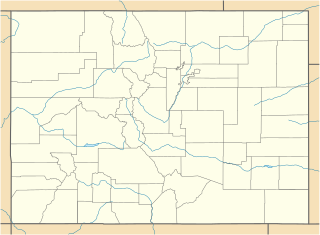
Foxton is an unincorporated community in Conifer Jefferson County, Colorado, United States. The U.S. Post Office at Conifer now serves Foxton postal addresses.
Cypress is a name used for many plants, including the conifer family Cupressaceae, but also other trees, vines, and small shrubs
See Cypress for a list of plant articles.

Wilding conifers, also known as wilding pines, are invasive trees in the high country of New Zealand. Millions of dollars are spent on controlling their spread.

Peardale is an unincorporated community in Nevada County, California, United States, along State Route 174, southeast of Cedar Ridge, California and northwest of Chicago Park, California. Its elevation is 2,710 feet (830 m) above sea level.

The spermatophytes, also known as phanerogams or phaenogams, comprise those plants that produce seeds, hence the alternative name seed plants. They are a subset of the embryophytes or land plants. The term phanerogams or phanerogamae is derived from the Greek φανερός, phanerós meaning "visible", in contrast to the cryptogamae from Greek κρυπτός kryptós = "hidden" together with the suffix γαμέω, gameein, "to marry". These terms distinguished those plants with hidden sexual organs (cryptogamae) from those with visible sexual organs (phanerogamae).

Coniferous swamps are forested wetlands in which the dominant trees are lowland conifers such as northern white cedar. The soil in these swamp areas is typically saturated for most of the growing season and is occasionally inundated by seasonal storms or by winter snow melt.
Conifer is an unincorporated community in Jefferson County, in the U.S. state of Pennsylvania.

